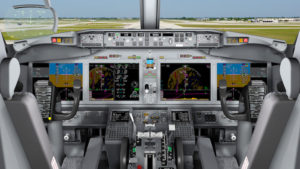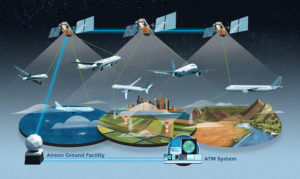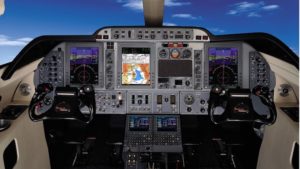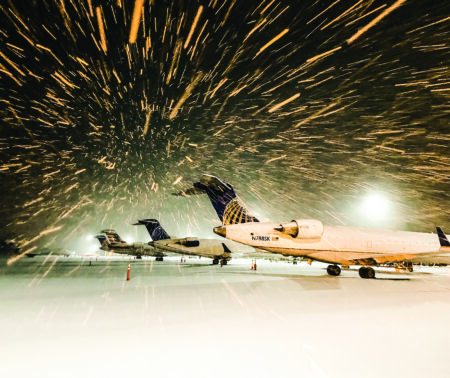Words by Ben Sampson
Despite concerns over meeting deadlines, ADS-B offers business aviation companies opportunities
to improve safety and processes.
Space-based ADS-B Out enables suitably equipped aircraft to broadcast their position via a datalink to a ground station. The aircraft determines its position using global positioning system (GPS) satellites and then uses a transmitter to communicate that position at short intervals to ground stations.
The technology lets air traffic controllers track the location of aircraft anywhere at any time, enabling efficiency and safety benefits. The first commercial space-based ADS-B service, run by Aireon, launched earlier this year (see box ADS-B trials) and with several deadlines for the mandatory installation and operation of ADS-B Out approaching over the coming months, including in the USA and Europe, the technology can no longer be ignored by business aviation operators.
Simon Hocquard is director general of CANSO, the global trade association for air navigation service providers. He is genuinely excited about the new technology, which he calls a “game-changer”. He says, “When I was working as a controller in the UK it never ceased to amaze me that aircraft would disappear as they travelled over the North Atlantic and then reappear on the other side. You would count them on the way in and way out. To have the capability now to see aircraft anywhere in the world at any time is extraordinary.”
Deadline exceptions

K65930
Such a large advance in ATC technology impacts the way business aviation flights are planned and managed. But the immediate consideration for business and general aviation has been fitting out aircraft to ensure they meet the mandated deadlines for ADS-B Out (see box ADS-B basics).
With a fleet of thousands of aircraft, one of the most contentious issues in the USA has been what happens if an aircraft is not ADS-B Out equipped in time for the FAA’s January deadline. In April, the FAA issued a policy that outlined how aircraft without ADS-B may be able to operate in restricted airspace. The exception gives aircraft one-off allowances at ATC’s discretion and will be used when an aircraft that normally operates outside of an ADS-B mandated environment needs to move through an ADS-B mandated environment.
David Kang, Avplan trip support account manager says, “This is not a waiver or permit for ADS-B. The FAA has stated clearly that multiple requests in a short time period will not be allowed. These exemptions will likely be applied to foreign aircraft, ferry/delivery aircraft and medical emergencies.
“There is no reasonable way of getting around this mandate for any corporate flight department. Quite simply, those who do not have it installed will find themselves grounded,” Kang adds.
Aircraft without ADS-B equipped will not be able to operate in Class A, B or C airspace, or any airspace above 10,000 ft mean sea level over the contiguous 48 states. The extent of airspace covered by the ADS-B mandate means flight and support will be “virtually impossible” if a charter operator’s aircraft does not have ADS-B, believes Kang. “The case-by-case exception is coordinated at the time of departure with ATC and there is no guarantee the operator will be cleared — this makes planning an operation extremely problematic.
“At the trip support company’s end, we cannot help the operator get the clearance with ATC. The operator has to become compliant before planning any operations.”
Space gains

Eventually, ADS-B will become the primary communication method between air traffic controllers and aircraft. ADS-B technology also shifts the primary navigation method to GPS and will use radio beacons and radar as a secondary method. In the future, very high frequency omni-directional range (VOR) navigation systems will be gradually decommissioned as they become unnecessary. An ADS-B transmitter will report telemetry once per second, while current transponders vary anywhere from once every 3 to 12 seconds. Kang says, “If you are flying in a congested airspace like metro New York, 12 seconds is an eternity for controllers to not be entirely sure where an operator is.
“This is a major change to flight operations around the world. Whether one thinks it is good or not is immaterial — but what is clear is that it is a necessity if we want to fit more aircraft into the same airspace.”
Safety benefits
The primary advantage ADS-B provides to business aviation is the facilitation of better communications with aircraft, which alongside the constant stream of location data, provides gains in safety. Kang says, “Most air traffic incidents happen from miscommunication and this technology will help to mitigate that.
“The steady stream of telemetry from the aircraft also means we can more reliably track aircraft to offer ground support. If an aircraft needs to divert, we will see it happening in real-time, so a sudden change of plans will be immediately actioned.
“Currently, if something does go wrong mid-flight, we may only know about it after the crew lands somewhere and calls in. Until then, the crew is basically on its own. With this technology, we can always have someone watching over them wherever they are.”
Kang says, “Business aircraft that are properly equipped will also gain access to airspaces, procedures and airports that are normally only available to airlines.
“The efficiency of air traffic operations will also increase as we switch to global positioning satellite systems as the primary navigation method. Flight routes will become more direct with less intermediate fixes.
“Flying over VORs as a navigation fix will become a thing of the past as navigational precision increases. And, while more direct routing may only shave off a few minutes per leg, over the course of a year, that can turn into hours of flight time saved. This also reduces fuel burn, and general wear and tear on aircraft.

As well as safety improvements, the advent of ADS-B Out will have help to reduce costs. For example, Nav Canada and NATS are using it across the North Atlantic already. A recent study has shown that it saves up to US$300 per flight over the North Atlantic. “Space-based ADS-B will change how people do air traffic control,” says Hocquard. “There’s huge momentum behind it.”
Space-based ADS-B also means nations yet to build infrastructure for air traffic management can effectively jump forward in terms of air traffic management (ATM) without a large and costly investment. This could potentially open up new markets to business aviation.
“For example, in Africa it’s difficult to build radar installations because of the distances involved. Other parts of the world are really mountainous. Now an ANSP can buy the surveillance information about an aircraft’s position and jump straight to the next generation of ATM technology,” says Hocquard.
European changes
Aaron Child is responsible for business aviation marketing in Europe, the Middle East and Africa for Collins Aerospace. He agrees that amongst airspace modernization initiatives, ADS-B out is of vital importance.
“The intent is to give ATC more capacity to handle more traffic, decrease delays, and control costs. These are all good things,” he says.
“European air traffic is increasing steadily every year and over each of the last five years delays have also increased. Eurocontrol statistics show that enroute ATC capacity is the number one reason for delays.”
Similarly to US aircraft, an ADS-B upgrade for most European aircraft, which should be equipped for Flight ID, will involve a new transponder and GPS. Aircraft which already have a flight management system with LPV (localizer performance with vertical guidance) are unlikely to need to upgrade their GPS, believes Childs.
“Most installations require only a minor amount of wiring. There may be other associated equipment to upgrade or install. We generally promote comprehensive upgrade packages so that the operators can benefit from operational benefits in addition to meeting the mandate,” he adds.

Collins’s ARINCDirect flight planning operations and communications services already includes flight tracking by FlightAware, which incorporates ADS-B and other data points. Space-based ADS-B will be offered as an option in the package, says Child: “Aircraft operators will gain from real-time updates and improved decision-making and hazard avoidance in what is an increasingly complex, but better-managed airspace system.”
Despite the availability of upgrade paths, according to the Single European Sky ATM Research deployment manager, which oversees the introduction of new ATC technology in Europe, as of July 2019 less than 50% of aircraft had been equipped for ADS-B. The European deadline for ADS-B is June 7, 2020. European aircraft flying to the US will also be required to have ADS-B equipment by January 2020. Childs says, “The biggest issue is timing. You don’t want to be caught in a rush or be delayed due to a backlog for installation. It’s best to plan ahead and beat the rush.
“Feedback from our dealer network indicates that operators are requesting quotations to make the upgrade, but not all are taking action to sign for the install. Even though installs are picking up in frequency, a backlog appears to be forming.”
Perhaps the continuous upgrading of avionics is what is causing operators to procrastinate over delays, although in the case of ADS-B Out, the mandatory nature of the upgrade and its benefits make avoiding it entirely a tactic unlikely to be successful. ADS-B Out is also just one of several space-based technologies on the horizon for avionics which are intended to improve communications and the flow of air traffic. “We can’t guarantee operation forever, but the best path to future-proof is to follow the recommendations of the aircraft manufacturer and avionics manufacturer. This is the most likely way to stay in the planned life cycle of the avionics and OEM-approved installations,” says Childs.
“ADS-B is just the starting point,” says Kang. “This technology is the gateway for all future airspace developments and policies. Allowing airspace to be fuller while becoming safer is a win-win.”





